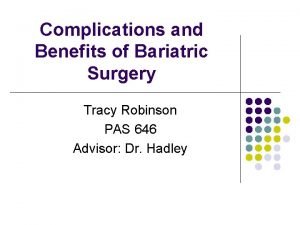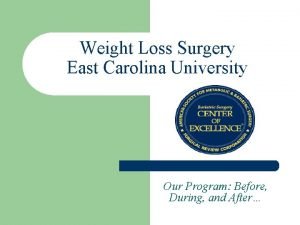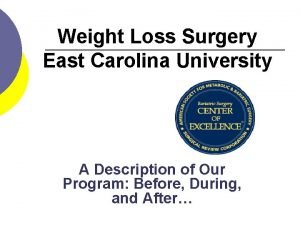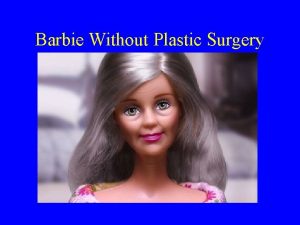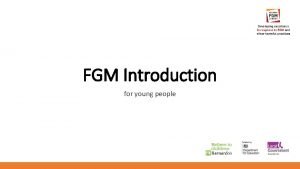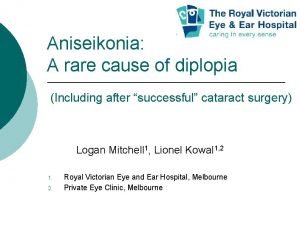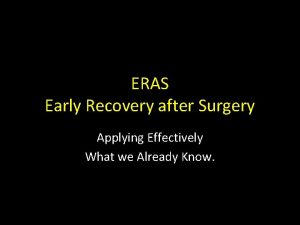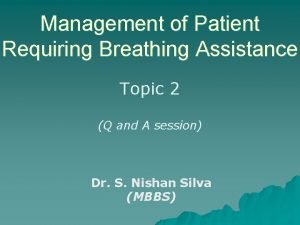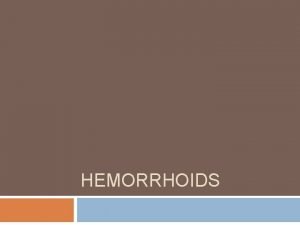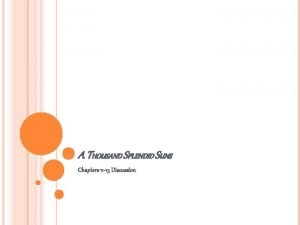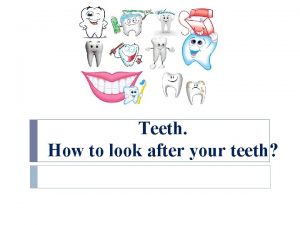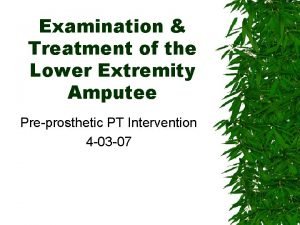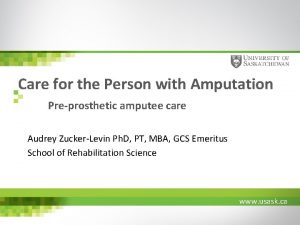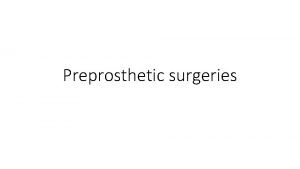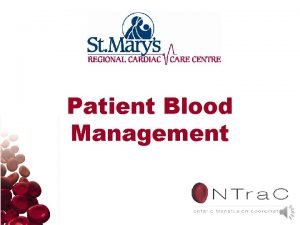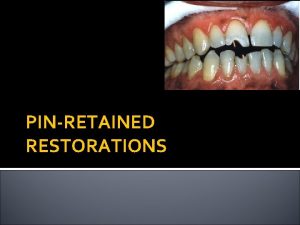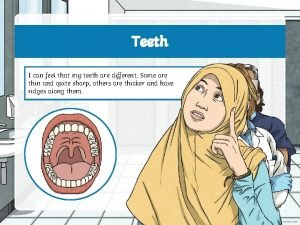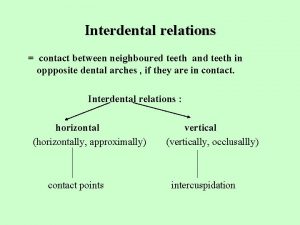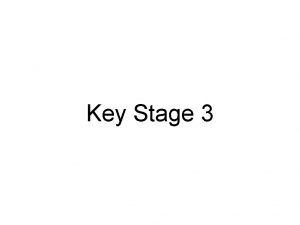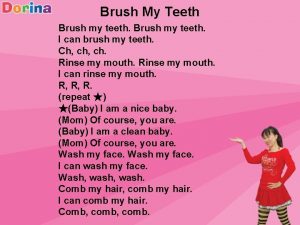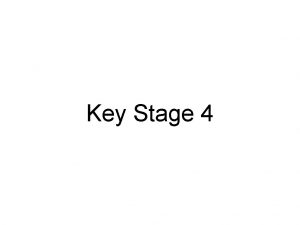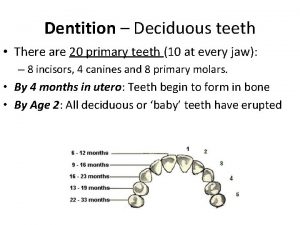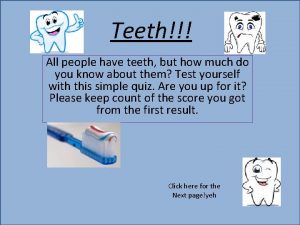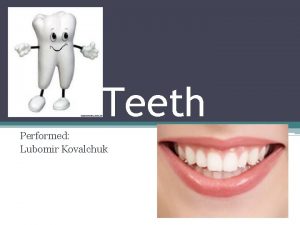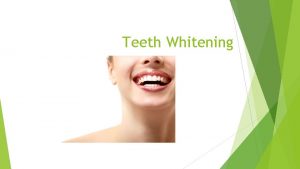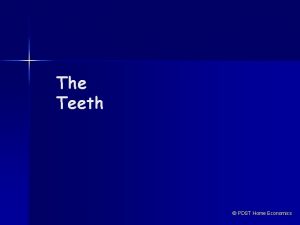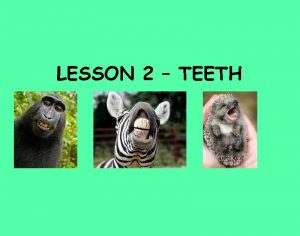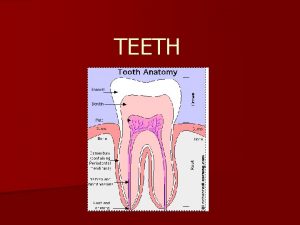Preprosthetic Surgery After the loss of natural teeth




















































- Slides: 52

Preprosthetic Surgery After the loss of natural teeth, bony changes in the jaws begin to take - place immediately because the alveolar bone no longer respond to stresses placed in this area by the teeth and periodontal ligament. Bone begins to resorb the specific pattern of resorption is unpredictable in a given patient because great variation exists among individuals. This resorption tend to effect the mandible more severely than maxilla because of decreased surface area and less favorable distribution of occlusal of force





objective of Preprosthetic surgery The objective of (P. S) is to create proper supporting structures for subsequent placement of prosthetic appliances. The best denture supports has the following characteristic: Ø No evidence of intra oral or extra oral pnthologic conditions. Ø Proper inter arch relationship. Ø Alveolar processes that are as large as possible and of proper configuration. Ø No bony or soft tissue protuberances or undercuts. Ø Adequate palatal vault form Ø Proper posterior tuberosity notching. Ø Adequate vestibular depth for prosthesis extension. Ø Adequate bony support and attached soft tissue covering.

Principles of patient evolution and treatment planning Preprosthetic surgical treatment must begin with a thorough history and physical examination of the patient and, a thorough assessment of overall general health is important especially when considering more advanced Preprosthetic surgical techniques. Specific attention should also be given to possible systemic disease that may be responsible, for the sever degree of bone resorption. Lab. tests such as serum levels &calcium, phosphate, parathyroid hormones and alkaline phosphates May be useful in pinpointing potential metabolic problems that ma affect bone resorption.

Examination of the supporting bone should include visual inspection, palpation, radiographic examination , and in some cases evaluation of models. Evaluation of the denture-bearing area of the maxilla. No bony undercut or gross bony protuberances that block the path of denture insertion Adequate post tuberosity notching must exist for posterior denture stability and peripheral seal. The remaining mandibular ridge should be evaluated. Visually for overall ridge form and contour, gross ridge irregularities, tori and buccal exostosis. Proper radiographs are an important part of the initial diagnosis and treatment plan. 0. P. G technique provide an excellent overview assessment of underlying bony structure and pathologic conditions.

Recontouring of alveolar ridges: The objectives of this procedure. Is to provide the best possible tissue contour for prosthesis support. Ø alveoloplasty associated with removal of multiple teeth: The simplest form of alveoloplasty in combination with multiple extractions carried out after all of the teeth in the arch have been removed. a technique is essentially that the bony areas requiring recontouring should be exposed using an envelope type of flap. Amucoperiosteal incision along the crest of the ridge with adequate extension anteroposterior to the area to be exposed , then recontouring can be accomplished with a rongeur, a bone file, or a bone bur in a hand piece. Alone or in combination. In any case normal saline irrigation should be used throughout the procedure to avoid overheating and bone necrosis, after that the flap should be re-approximated by digital pressure and the ridge palpated to ensure that all irregularities have been removed.

Alveoloplasty


Ø Intraseptal alveolplasty an alternative to the removal of alveolar ridge irregularities by simple alveoloplasty technique. is the use of an intraseptal alveoloplasty or Dean's technique involving the removal of intraseptal bone with repositioning of the labial cortical bone, rather than removal of excessive or irregular areas of the labial cortex.




maxillary tuberosity reduction Horizontal or vertical excess ( or both ) of the maxillary tuberosity area may be a result of excess bone. Recontouring of the maxillary tuberosity area may be necessary to remove bony ridge irregularities or to create a adequate inter-arch space. Surgery can be accomplished using local anesthesia. Access to the tuberosity for the bone removal is accomplished by making a crestal incision that extends up to the posterior aspect of T area, reflection of a full thickness mucoperiosteal flap is completed in both buccal and palatal direction, bone can be removed using either aside-cutting rongeur or rotary instrument with care taken to avoid perforation of the floor of the nose after the appropriate amount of bone has been removed the area should be smoothed with a bone file and irrigated with saline. The mucoperiosteal flaps can then be readapted.

maxillary tuberosity reduction




Buccal exsostosis and excessive undercuts Excessive bony protuberance and resulting undercut arms are more common in the maxilla than the mandible. Although extremely large areas of bony exsostosis generally require removal. But small undercut area or bony buccal protuberance if removed results in a narrowed crest in the alveolar ridge area and a less desirable area of support for the denture. , As well as an area that may be resorb more rapidly.

buccal exostosis and excessive undercut


Removal of small exstosis lead to narrow crest and more resorption

Mylohyoid ridge reduction One of the more common area interfering with proper denture construction in the mandible is the mylohyoid ridge with its easily damaged thin covering of mucosa, the muscular' attachment to this area often is responsible for dislodging the denture When this ridge is extremely sharp, denture pressure may produce significant pain in this area. Inferior alveolar, buccal and lingual nerve blocks are required , a linear incision is made over the crest of tie ridge in the posterior. aspect of the mandible. Extension of the incision too far to the lingual aspect should be avoided because this may cause potential trauma to the lingual nerve. A full-thickness mucoperiosteal flap is reflected which exposed the mylohyoid ridge area and muscle attachments. This attachment are removed from the ridge by sharp incising tilt muscle attachment at the of area of bony origin. When the muscle is released the underlying fat is visible in the surgical field. After reflection of the muscle a rotary instrument or bone file can be used to remove the sharp prominence of the mylohyoid ridge.

mylohyoid ridge reduction


Genial tubercle reduction: As the mandible begins to undergo resorption. The area of the attachment of the genioglossus muscle in the anterior portion Of the mandible may become increasingly prominent. Which. require reduction to construct the prosthesis properly. Before a decision to remove the prominence is made consideration should be given to possible augmentation of the anterior border of the mandible rather than reduction of the g. tubercle. If augmentation is the preferred treatment the tubercle should be left to add support to the graft in this area.

genial tubercle reduction

Ridge augmentation cancel the need for reduction

Maxillary Tori maxillary tori consist of bony exostosis formation in the area of approximately twice the percentage in males. Tori may have multiple shapes and configurations ranging from a single smooth elevation to a multiloculated pedunculated bony mass. This bony mass interfere with proper design and function of the prosthesis. Surgical removal began with bilateral greater palatine and incisive blocks a linear incision in the midline of the tours with oblique vertical releasing incisions at one or both ends is generally necessary. A full palatal flap can be used to expose the multiloculated tori then an osteotome and mallet may be used to remove the bony mass. For larger tori it is usually best to section the tori into multiple fragments with a bur in a rotary hand piece careful attention must be paid to the depth of cuts to avoid perforation of the floor of the nose then the mucosa is reapproximated and sutured to prevent hematoma formation some form of pressure dressing must be placed over the area of the palatal vault.

maxillary tori Different shapes



Mandibular tori are bony protuberance on the lingual aspect of the mandible that usually occur in the premolar area The origins of this bony exostosis are uncertain and the growths may slowly increase in size occasionally extremely large tori interfere with normal speech or tongue function during eating. But, this tori rarely require removal when they are present after the removal of lower teeth and before the construction Of partial or complete dentures. It may be necessary to remove mandibutar tori to facilitate denture construction.

mandibular tori


Soft tissue abnormalities of the soft tissue in the denture-bearing and peripheral tissue area include excessive fibrous or hyper mobile tissue, inflammatory lesions and abnormal muscular and frenal attachments. Ø Un supported hyper- mobile tissue: Excessive hypermobile tissue without inflammation on the alveolar ridge is generally the result of resorption of the underlying bone ill-fitting denture or both. if a bony deficiency is the primary cause of soft tissue excess then augmentation of the underlying bone is treatment of choice. But if the height of alveolar bone is adequate then excision of hyper mobile tissue is indicated. A local anesthesia is injected removal of hyper mobile tissue consists of two parallel full-thickness flaps on the buccal and lingual aspects of the tissue to be excised. A periosteal elevator is used to remove the excess soft tissue from the underlying bone than continuous or, interrupted sutures are used to approximate the remaining tissue and are removed 7 day after surgery.

Soft tissues abnormality (excessive fibrous or hypermobile)

Inflammatory fibrous hyperplasia: I. F. H also called epulis or denture fibrosis is a generalized hyperplasic enlargement of mucosa and fibrous tissue in the alveolar ridge or vestibular area. Which most often result from illfitting dentures. 2 technique can be used either electrosurgical or laser techniques provide good results for tissue excision or by grasping the tissue with tissue forceps. A sharp incision is made at the base of fibrous tissue down to the periosteum the adjacent tissue is gently under mined and re approximated using interrupted or continuous sutures.

Inflammatory fibrous hyperplasia denture epulis


labial frenectomy: labial frenum attachments consist of thin bards of fibrous tissue covered with mucosa extending from the lip and cheek to the alveolar periosteum. The level of frenal attachments may vary from the height of the vestibule to the alveolar ridge and even to the area in the anterior maxilla. Three surgical technique are effective in removal of frenal attachments: Ø The simple excision Ø The Z-plasty. Ø A localized vestibuloplasty with secondary epithelialization. For the simple excision technique a narrow elliptic incision around the frenal area down to the periosteum , The fibrous frenum sharply dissected from the underlying periosteum and soft tissue then the margins of the wound are gently undermined and re approximated. Placement of the first suture should be at the maximum depth of the vestibule and should include both edges of mucosa and underlying periosteum.

Labial frenectomy



Lingual frenectomy An abnormal frenal attachment usually consists of mucosa, dense fibrous connective tissue. This attachment binds the tip of the tongue to the posterior surface of the mandibular alveolar ridge. Surgical release of the lingual frenum requires incising the attachment of the fibrous connective tissue at the base of the tongue in a transverse fashion followed by , closure in a linear direction which completely release the anterior portion of the tongue. Ø Transpositional flap vestibuloplasty A lingually based flap vestibuloplasty procedure is explained as mucosal flap pedicled from the alveolar ridge is elevated from the underlying tissue aid sutured to the depth of the vestibule The inner portion of the lip is allowed to heal by secondary epithetiazation. The objectives of this procedure is to increase the anterior vestibular area. .

Indication of the procedure: When there is inadequate facial vestibular depth from mucosa' and muscular attachments in the anterior mandibular and the presence of inadequate vestibule depth on the lingual aspect of the mandible. disadvantages of this procedure include unpredictability of the amount of relapse of the vestibular depth. Scarring in the depth of the vestibule and problems with adaptation of the peripheral flange area of the denture to the depth of the vestibule.

Lingual frenectomy

mandibular augmentation: - Augmentation grafting adds strength to an extremely ddicient mandible and improves the height and contour of the available bone for implant placement on denture-bearing areas. Sources of graft material include autogenous or allogenous bone and alloplastic materials. Historically autogenous bone has been shown to be the most biologically acceptable material used in (MA). Disadvantages of the use of autogenous bone include the need for donor site- surgery and extensive resorption after grafting. The use of allogenic bone eliminate the need for a second surgical site and has been shown to be somewhat useful in augmenting small area of concavity in the posterior mandible. The hydroxy apetite (HA) alloplastic materials used in bony augmentation of the maxilla and mandible. The material is readily available, eliminate the need for donor-site surgery and has been shown to improve long-term maintenance of height and contour. The disadvantage includes tissue dehiscence, migration of the material and neurosensory disturbance have resulted in less frequent use of this material.

vestibuloplasty

mandibular augmentation
 John 14:1-3
John 14:1-3 After me after me after me
After me after me after me Bariatric weight loss surgery near tracy
Bariatric weight loss surgery near tracy Erosion stomach
Erosion stomach Ecu weight loss surgery
Ecu weight loss surgery St agnes weight loss surgery
St agnes weight loss surgery Unit cost meaning
Unit cost meaning Pam ayre
Pam ayre Lower lip ptosis
Lower lip ptosis Fgm.
Fgm. Knapps rule
Knapps rule Early recovery after surgery
Early recovery after surgery ütube
ütube After hemorrhoid surgery pictures
After hemorrhoid surgery pictures Coming off amitriptyline weight loss
Coming off amitriptyline weight loss Chapter 15 a thousand splendid suns
Chapter 15 a thousand splendid suns Grief is a natural response to a serious loss
Grief is a natural response to a serious loss Natural hazards vs natural disasters
Natural hazards vs natural disasters Natural capital and natural income
Natural capital and natural income điện thế nghỉ
điện thế nghỉ Phối cảnh
Phối cảnh Một số thể thơ truyền thống
Một số thể thơ truyền thống Thế nào là hệ số cao nhất
Thế nào là hệ số cao nhất Trời xanh đây là của chúng ta thể thơ
Trời xanh đây là của chúng ta thể thơ Hệ hô hấp
Hệ hô hấp So nguyen to
So nguyen to đặc điểm cơ thể của người tối cổ
đặc điểm cơ thể của người tối cổ Các châu lục và đại dương trên thế giới
Các châu lục và đại dương trên thế giới Chụp tư thế worms-breton
Chụp tư thế worms-breton ưu thế lai là gì
ưu thế lai là gì Tư thế ngồi viết
Tư thế ngồi viết Bàn tay mà dây bẩn
Bàn tay mà dây bẩn Các châu lục và đại dương trên thế giới
Các châu lục và đại dương trên thế giới Mật thư tọa độ 5x5
Mật thư tọa độ 5x5 Bổ thể
Bổ thể Từ ngữ thể hiện lòng nhân hậu
Từ ngữ thể hiện lòng nhân hậu Tư thế ngồi viết
Tư thế ngồi viết V cc
V cc Thẻ vin
Thẻ vin Thể thơ truyền thống
Thể thơ truyền thống Hát lên người ơi
Hát lên người ơi Khi nào hổ mẹ dạy hổ con săn mồi
Khi nào hổ mẹ dạy hổ con săn mồi Diễn thế sinh thái là
Diễn thế sinh thái là Vẽ hình chiếu vuông góc của vật thể sau
Vẽ hình chiếu vuông góc của vật thể sau Công thức tiính động năng
Công thức tiính động năng Làm thế nào để 102-1=99
Làm thế nào để 102-1=99 Tỉ lệ cơ thể trẻ em
Tỉ lệ cơ thể trẻ em Lời thề hippocrates
Lời thề hippocrates Vẽ hình chiếu đứng bằng cạnh của vật thể
Vẽ hình chiếu đứng bằng cạnh của vật thể đại từ thay thế
đại từ thay thế Quá trình desamine hóa có thể tạo ra
Quá trình desamine hóa có thể tạo ra Môn thể thao bắt đầu bằng từ chạy
Môn thể thao bắt đầu bằng từ chạy


